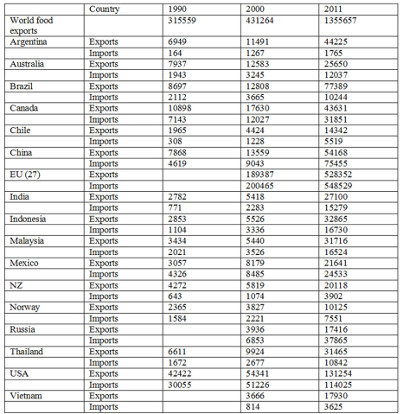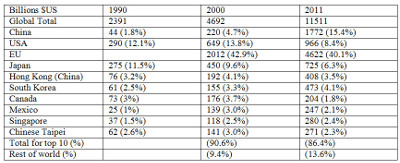I argue that even the most recent economic policy trends have little relevance if we are to deal effectively with the policy difficulties ahead.
This is despite my past support for freer trade, albeit with a qualification that such an agenda should be questioned by liberal democracies if their standard of living 'declined to the point where they cannot compete effectively with nations that have an abundance of cheap labour' (Quadrant, November 2006, p. 54)
In other words, while Australia had good reason to reject an earlier emphasis upon high tariff protection and a White Australia policy, the shift away from such protection has downplayed negative aspects of recent policy trends.
Advertisement
Since the 1980s, Australia adopted policy reform in line with the demands of a much more competitive and open international economic environment while successfully maintaining social consensus through greater social welfare assistance.
Like many other nations, with capital and production more easily flowing around the world looking for a greater return or to reduce production costs, Australia (in general terms) has sought to promote investor confidence by promoting balanced budgets, lower tariff and taxation levels, and labour market deregulation.
To a large degree, both Labor and Coalition governments achieved considerable success. In terms of economic growth, Australia has been one of the best performers amongst OECD nations, recently ranking 5th in the world in terms of per capita GDP (IMF 2011). Australia also managed to maintain a similar level of inequality since the early 1980s, in contrast to a majority of OECD nations.
But do not be fooled by such achievements as future economic policy difficulties may be evident, a possibility that will complicate Australia's ability to adopt a reasonable economic, social and environmental policy mix.
Take the importance of trade given that the exports of merchandise goods alone constitutes around 20 per cent of Australian GDP and is deemed crucial to uphold the viability of many Australian industries.
To some degree, Australia has succeeded. In an expanding global economy, Australia was fortunate to benefit from mining and fuels being the fastest growing export sector between 1990 and 2011 (see Table 1).
Advertisement
Table 1: World merchandise exports by major product group, (sourced from WTO)

By 2011-12, coal and natural gas contributed around $60 billion of Australia's total goods and services worth around $316 billion, along with around $63 billion for iron ore and concentrates exports, and $50.5 billion of services.
But what of other industry sectors, especially others promoted as representing Australia's supposed comparative advantage.
Take food exports. On 12 September 1996, Prime Minister Howard (House of Representatives) noted the potential for Australian agriculture with an estimate that the total East Asian food market would be worth around $685 billion by 2000, including a need for $83 billion of imports.
While Table 2 data indicates that Australia's food exports increased by 323 per cent between 1990 and 2011, Australia was easily outperformed by other nations as its global share declined from 2.5 to 1.9 per cent. Australia's food export to import ratio also worsened from 408% in 1990 to 213% in 2011, amongst the worst declines of the leading food export nations.
Table 2: WTO trade data (Food exports in millions of US dollars)

And with many Australian farmers facing much higher debt and declining equity, with average farm debt doubling from the late 1990s to be $460,000 by June 2011, an economist and farmer from Queensland, Ben Rees, argues that the support for food producers is now affecting small and large scale farmers with the "philosophical structural reforms of the 1980s" having "transformed the small scale farm, low income problem into one where now large players are facing collapse".
Now, one could argue that mining and agricultural exports do not alone define the well-being of the economy. After all, Australia's agriculture and mining sectors represented just 5 per cent of Australian employment by the end of 2012, with the expansion of services employment making up for manufacturing jobs declining from 16 to 8 per cent since late 1984.
But in economic terms, is it enough for Australiato specialize in certain industries to enable us to always maintain a high standard of living, even allowing for a recent prediction that Australia's resource exports would increase by 50 per cent over the next five years?
Is it enough to claim huge potential in terms of services? In 2011, Australia had 1.5% of global merchandise exports and 1.2% of global service exports, yet total global merchandise exports still dwarfed global exports by over 4 to 1 ($US18,255 billion to $US4,170 billion).
With Australia's share of global manufacturing (non-food) exports also declining further from 0.29 to 0.24 per cent between 1990 and 2011 at a time when they globally still comprised around 65 per cent of total merchandise exports in 2011 (70 per cent 2000), Australia is now competing with emerging major economic players (such as Brazil) for a minority of global exports (non-manufacturing exports).
As table 3 indicates, when including the EU-27 entity, the top ten entities still had 86.4 per cent of global manufacturing exports with the rest of the world sharing a mere 13.6%.
Table 3: Share of global manufacturing exports (non-food) (% of global total in brackets)

At the same time, our high reliance upon retail (over 10 per cent of employment at the end of 2012) faces much greater competition from online purchasing with customers able to import any number of individual shipments that is below threshold of $1,000 with no tax or duty to be paid. Nothing has been done after a Productivity Commission concluded that it would cost $2 billion to raise $600 million of extra tax revenue.
Truth is that Australia's adherence to free trade is limited with our struggle with manufacturing and food exports meaning that tougher times lie ahead in terms of generating economic activity.
What are the solutions? More public debt?
More household spending, despite Australia already having one of the highest levels of household debt?
A free trade deal with mercantile and authoritarian China at a time when the former US Treasury Secretary argued that the US needs to do a better job at policing the Chinese cyber menace if the global economic system is to be preserved? It is argued that 'two thirds of American computer software used in China is stolen' and up 'to 20 per cent of China's growth is connected in some way to theft of intellectual property'
Even if recent trends are to occur relatively peacefully, Australia would be wise to observe potential consequences from its current economic policy stance.
Consistent with the evidence in Table 1, Ian Fletcher, an adjunct fellow with the U.S. Business and Industry Council, noted that the decline of manufacturing can hardly be offset by 'exporting soybeans and investment-banking services'.
Fletcher also argued that non-elite service-industry jobs 'are also much more productivity-constrained than manufacturing, so you're never going to be able to pay most people decent wages there'. As jobs are lost offshore, Fletcher argues that a mirage is created under the belief that higher productivity jobs remain yet there is 'no guarantee that the workers who formerly held them will find new jobs of equal or greater value'. This occurs as jobs are lost to foreign nations which subsidise production to get a foothold in strategic industries.
While no sensible commentator would suggest a return to absolute protection to give narrow interest groups special immunity from market discipline, they have good reason to challenge their own losses to other more mercantile nations.
While Fletcher's prefers a 30 per cent flat tariff on all imports to bring back high-value industries like producing flat-panel displays, another article suggests that Western societies should not merely turn a blind eye in the hope of economic gain with investor and business interests given the highest priority, 'while sweeping aside the environment, labour rights, human rights, public health and reasonable regulations'.
No one can imply the answers are easy. They are not. If we are to again have an expanding manufacturing industry we will have to become more competitive, including in terms of labour costs.
But at a time when powerful governments (US, EU and Japan) print money in the hope something magical will happen beyond the need for dramatic reform, don't be fooled by Gillard's recent claim that Australia will be ready for the Asian Century through skills and education, high speed broadband, clean energy and innovation, competition and deregulation, and tax reform (AAP, 4 April 2013).
To be frank, economic policy solutions are not going to be easy, as evident by the ongoing demise of the Australian car-making industry compounded by high dollar, high costs, excess overseas capacity, and by Japan devaluing its currency which makes its cars even cheaper (Matt Chambers and Ewin Hannan, 'End of carmakers 'inevitable' as former Ford president Jac Nasser warns of 'domino effect'', The Australian, 12 April 2013).
Tough times may be ahead, so we need to search hard for a sophisticated way out rather than merely accepting a silly notion that Australia will do well just by relying on minerals and food.